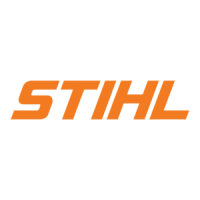11MS 192 T
English / USA
When the inhalation of toxic dust, mists
and fumes cannot be eliminated, the
operator and any bystanders should
always wear a respirator approved by
NIOSH / MSHA for the type substance at
issue.
!Warning!
Breathing asbestos dust is dangerous
and can cause severe or fatal injury,
respiratory illness or cancer. The use
and disposal of asbestos containing
products have been strictly regulated by
OSHA and the Environmental Protection
Agency. Do not cut or disturb asbestos,
asbestos containing products (e.g.
asbestos containing drywall or other
construction products), or products such
as pipes which are wrapped or covered
with asbestos insulation. If you have any
reason to believe that you might be
cutting asbestos, immediately contact
your employer or a local OSHA
representative.
Operate the saw under good visibility
and daylight conditions only. Don't work
alone. Keep within calling distance of
others in case help is needed. Helpers at
the cutting site must also wear protective
clothing (such as hard hat) and stand
well clear of the branches being cut.
Be particularly cautious and alert while
wearing hearing protection because
such equipment may restrict your ability
to hear sounds indicating danger (calls,
signals, warnings, etc.).
!Warning!
Take extreme care in wet and freezing
weather (rain, snow, ice). Put off the
work when the weather is windy, stormy
or rainfall is heavy.
!Warning!
Clear the area where you are working.
Avoid stumbling on obstacles such as
stumps, roots or rocks and watch out for
holes or ditches. Be extremely cautious
when working on slopes or uneven
ground. There is increased danger of
slipping on freshly debarked logs.
Operate your chainsaw so that it
produces a minimum of noise and
emissions - do not run engine
unnecessarily and accelerate the engine
only for cutting. In order to keep control
of your saw, always maintain a firm
foothold. Never work on a ladder, or on
any other insecure support. Never use
the saw above shoulder height. Never
attempt to operate the saw with one
hand.
!Warning!
Never work in a tree unless you have
received specific, professional training
for such work, are properly secured
(such as lift bucket or tackle and harness
system), have both hands free for
operating the chainsaw in a cramped
environment and have taken
precautions to avoid injury from falling
obstacles.

